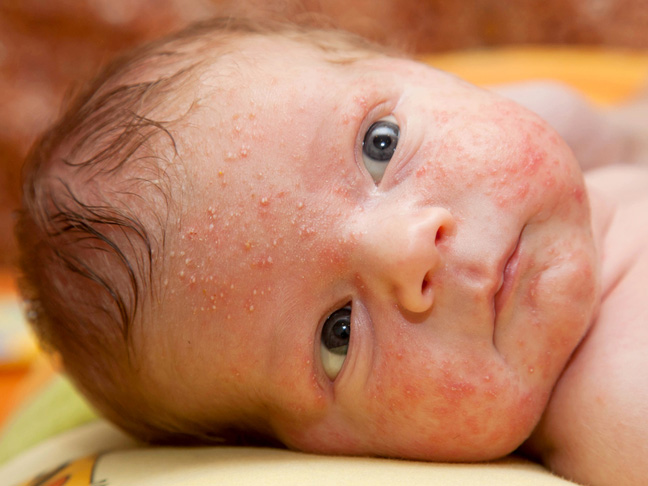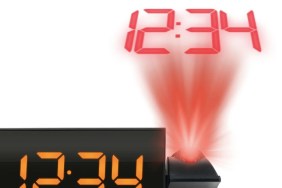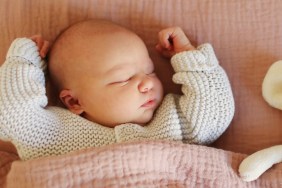Kathyrn Bowling’s son Gus was only two weeks old when she first noticed red bumps spreading on his face: newborn acne. At the time, the Atlanta mom wasn’t concerned about something so common (and harmless) as baby acne. I was worried about so many other things, like how much he was eating and whether I would get enough sleep,” she says. “In the grand scheme of things, a few bumps on his face didn’t seem too bad.”
Bowling was right not to worry. Baby acne — or newborn acne, as it’s called to distinguish it from infantile acne, which occurs in older babies — is usually harmless and quite common. “It occurs in about 20 percent of newborns, typically around the time when they’re 3 – to 4-weeks-old,” says Mary Yurko, M.D., PhD, a pediatric dermatologist in Grand Rapids, Michigan.
What are the symptoms of baby acne?
Baby acne is usually mild, and it’s limited to the face 99 percent of the time, says Teri Kahn, MD, clinical associate professor of dermatology and pediatrics at University of Maryland School of Medicine and Mt. Washington Pediatric Hospital in Baltimore. “Typically, baby acne appears in the form of little whiteheads and blackheads on the forehead, cheeks, and chin,” she says. Other skin conditions, like eczema, show up on other parts of the body.
What causes baby acne?
Doctors aren’t certain what causes it, but the leading theory is that, just like with teen acne, hormones are to blame. “Babies get a surge of Androgen hormones when they’re around a month old, and those hormones can cause enlarged oil glands and, ultimately, acne,” says Dr. Kahn. Oxytocin and Prolactin, which are the hormones that your baby gets from breastfeeding, don’t tend to cause pimples, she adds.
How is baby acne treated?
Baby acne generally goes away on its own after a month or so. As far as actual baby acne treatment, your pediatrician may suggest that you wash your baby’s face with warm water and a gentle soap, says Dr. Kahn. (There is no proof that breast milk, which some moms swear by as a homeopathic remedy, actually works.) Don’t pick at your baby’s acne; you’ll cause scarring, she warns.
When should you see a doctor for your child’s baby acne?
Check in with your pediatrician if your child’s newborn acne doesn’t clear up within a month or so, goes away and then comes back, appears to be painful, or is accompanied by unusual symptoms such as lethargy, poor appetite, or trouble sleeping, says Dr. Kahn.
If it doesn’t go away on its own, her pediatrician might prescribe a topical antibiotic cream. In extreme cases, Dr. Kahn says that babies can be treated with oral antibiotics, but unless your pediatrician is concerned about a risk of severe scarring or cysts, it’s unlikely he’ll recommend it.
What else looks like baby acne?
Baby acne can be confused with other conditions, although most of them are relatively rare:
1. Infantile acne
If your baby still has acne at 3- to 6-months-old, infantile acne may be the culprit. “These bumps tend to be more red and inflammatory,” says Dr. Kahn. “You’ll see more of the different types of acne than with baby acne, including pustules and cysts, not just whiteheads and blackheads.” And unlike baby acne, infantile acne is linked to family history: Your baby is more likely to get it if you or your partner had severe acne as a teen. Acne in older babies can also be an indication that your baby is more likely to have acne later in life. Like baby acne, infantile acne rarely needs treatment; if there’s a lot of redness and swelling, however, your doctor might want to treat it with a topical antibiotic.
2. Infection
Sexually transmitted infections like herpes and bacterial infections like Group B strep can cause bumps that look similar to acne. But, since both infections are typically transmitted from mom to baby during delivery, this should only be a concern if you had one of these infections during your third trimester, says Dr. Kahn.
If the bumps on your baby aren’t limited to her face, or if she has a fever or cold symptoms, call your doctor. It could be a viral infection like shingles, if you had an active infection while you were pregnant. Another good reason to make sure that your vaccines are all up to date before you get pregnant!
3. Eczema
Like baby acne, eczema is very common in newborns, but it’s usually caused by dry (not oily) skin. Mild eczema can cause lots of small bumps, similar to baby acne. Since it often starts on the cheeks, it’s easy to confuse with baby acne. But, if it spreads into a rash that covers the skin or develops in other areas of your baby’s body, such as the folds of his elbows and knees, then it’s probably eczema, not acne. Eczema isn’t usually serious. You can treat it by using a gentle hydrating lotion on your baby’s skin after bathtime.
Although baby acne can look painful, it usually doesn’t bother your baby — so don’t let it bother you, either. Most likely, you don’t need to do anything to treat it. Relax and wait, and it will go away on its own.
Photo: Getty








